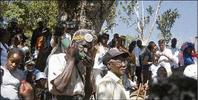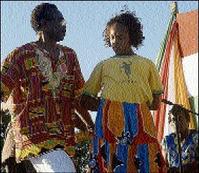Peter Kavanaugh, JIS Writer

A crowd gathers under a Kindah Tree at the 270th anniversary celebration of the signing of the peace treaty between Britain and the Leeward Maroons, held in January. - JIS Photos
It's January 6, 2008. In the distance you can hear the haunting, melodious tones of the abeng, the traditional war horn of the Maroons, as well as the steady beat of the Gumbay drum.
Our location - the Kindah (one family) mango tree in Accompong Maroon Village, St Elizabeth, and it's the annual celebration of Captain Cudjoe's birthday, an event that also serves to mark the 270th anniversary of the signing of the first peace treaty between Britain and the Leeward Maroons.
In modern-day Jamaica, Maroons may not have the same historical distinction as in pre-Emanciption Jamaica. Still, when one attends the annual festivities, one gets a sense that much is missing from the oral tales that are related to visitors by the elders of Accompong.
Colonel Sydney Peddie, current chief of the 20-member-strong Maroon Council, which was born out of the original treaty, is keen on preserving Accompong as an authentic bastion of Maroon heritage and culture.
According to Peddie (now in his second term), when he took over, he made overtures to outside entities such as the Ministry of Tourism to help revamp the tourist offerings of Accompong.
Museum

Colonel of the Charles Town Maroons, Frank Lumsden (left), engages a traditional Maroon dancer.
"With the input of Tourism Product Development Company (TPDCo), we were able to establish a museum, and traditional trails with accompanying signs and story boards. Many of our young people were also trained as tour guides under the Team Jamaica programme," he said.
But, as with most developments, the challenges were also real.
"Back then the celebrations had become highly commercialised and, as a result, visitors were seeing more pots and pans and plastic items, so we had a watering down of our system, which, after a while, was no more than a village fair instead of a ceremony which celebrated the hard-earned freedom brought about by the blood, sweat and tears of our ancestors," said Peddie.
"This could not continue, as to allow it would have meant the death knell of our people," We, therefore, have to be self-reliant. We have to rely to a large extent on the funds derived from our celebrations to carry on the work of the council."
Worthwhile partnerships
The colonel has also established some very worthwhile partnerships with the outside world. "We currently have a full-time American Peace Corps volunteer working out of my office to develop a number of income-generating projects," said Peddie.
After building an information centre, a special herbal garden and a 'bickle' village with the help of the Canadian International Development Agency, the Maroons suffered setbacks. But, according to Peddie, these have not daunted their drive to succeed.
"... Unfortunately, successive hurricanes wiped out a lot of our work ... . The spirit of our forefathers is still strong, however, so we will continue to try," he said.
The Accompong Development Foundation, which was set up as a registered non-profit entity in 2005, has also aided in the revival of heritage and culture.
Another achievement of the Accompong Foundation has been in the area of information com-munication technology equipment.
"With the help of one of our overseas-based volunteers out of Canada, Aoi Sakaya, in the last two years we have received more than six multimedia computers as well as some musical instruments and items of clothes, which were handed over to both our local primary and basic schools. We have also received a number of barrels containing books from New York, thanks to another volunteer."
Outstanding talents

Peddie
On the local and international stage, Accompong has fostered some outstanding talents. Only last year it was the turn of master drum maker, George Huggins, who received a bronze medal at the 2007 Musgrave Medal awards ceremony.
"Of course, in 1949, Katherine Durham came here and wrote her famous work 'Journey to Accompong'. Her main reason for visiting was to learn our songs and dance; this lady later went on to set up a revolutionary dance school in America, which has to this day influenced the modern dance form in that country," said Peddie.
Colonel Peddie outlined that the long-term vision of his office was to bring about a paradigm shift in Maroon life.
"We have to protect our history, especially our oral and herbal traditions, we have to see the value of our traditions and not let the outside world impact in such a way that, after a time, we became just another Jamaican community putting on an event or festival."
So, when next the magical sounds of the abeng and the rhythmic booms of the Gumbay drum call, know the Maroons are here to stay.
This is a special Gleaner/Jamaica Information Service feature collaboration. Send feedback to editorial@gleanerjm.com.

